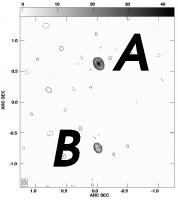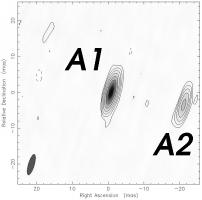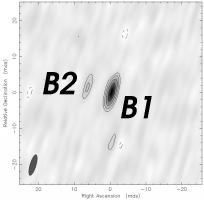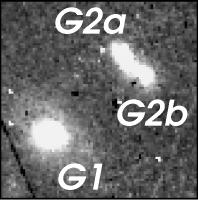Lens System Summary
The double-image lens B2319+051 was discovered in CLASS II. Modelling this system is difficult because no optical or IR identification of the radio images has been made, even in NICMOS data. VLBA substructure has been observed over a period of three years; no variations have been seen, making this system unsuitable for time delay measurements.
|
This Lens System
|
Lens name
|
B2319+051
|
|
Survey
|
CLASS
|
|
Images
|
2
|
|
B1950.0 coords
|
23h19m08.103s
|
05°11'09.883"
|
|
J2000.0 coords
|
23h21m40.801s
|
05°27'37.225"
|
|
Lens System Structure and Labelling
Image labelling for this lens (RA increases to the left, declination increases upwards)




|
Image/Lens Positions
|
Image/Lens
|
Relative Position
|
|
East (mas)
|
North (mas)
|
|
A1
|
+0.0
|
+0.0
|
|
A2
|
-20.3
|
-3.7
|
|
A3
|
-3.0
|
-2.4
|
|
B1
|
+11.3
|
-1363.8
|
|
B2
|
+18.8
|
-1363.8
|
|
Image/Lens Separations
|
Separation (mas)
|
|
Component
|
A1
|
A2
|
A3
|
B1
|
B2
|
|
A1
|
|
20.6
|
3.8
|
1363.8
|
1363.9
|
|
A2
|
20.6
|
|
17.3
|
1360.5
|
1360.7
|
|
A3
|
3.8
|
17.3
|
|
1361.5
|
1361.6
|
|
B1
|
1363.8
|
1360.5
|
1361.5
|
|
7.5
|
|
B2
|
1363.9
|
1360.7
|
1361.6
|
7.5
|
|
|
Position angle (°)
|
|
Component
|
A1
|
A2
|
A3
|
B1
|
B2
|
|
A1
|
|
79.7
|
51.3
|
-0.5
|
-0.8
|
|
A2
|
-100.3
|
|
-94.3
|
-1.3
|
-1.6
|
|
A3
|
-128.7
|
85.7
|
|
-0.6
|
-0.9
|
|
B1
|
179.5
|
178.7
|
179.4
|
|
-90.0
|
|
B2
|
179.2
|
178.4
|
179.1
|
90.0
|
|
|
Maps and Images
Click on an image to see a larger JPEG version, or click on the accompanying text to
download a gzipped FITS or PostScript file of the map or image. The images and maps are
available in one gzipped file here.
To see a DSS image of the region around this lens, click here - note that you will have to start the search manually by clicking on the 'Search' button.
|
Radio Flux Densities
|
Component
|
Flux density (mJy)
|
|
1.4 GHz
|
1.7 GHz
|
5 GHz
|
5 GHz
|
5 GHz
|
8.4 GHz
|
8.4 GHz
|
15 GHz
|
|
A
|
70.8
|
|
55.8
|
44.0
|
|
25.5
|
27.4
|
14.8
|
|
A1
|
|
42.7
|
|
|
31.0
|
|
|
|
|
A2
|
|
14.4
|
|
|
8.3
|
|
|
|
|
A3
|
|
9.4
|
|
|
0.8
|
|
|
|
|
B
|
14.5
|
|
10.8
|
8.8
|
|
5.3
|
5.0
|
3.4
|
|
B1
|
|
9.2
|
|
|
6.2
|
|
|
|
|
B2
|
|
2.8
|
|
|
1.9
|
|
|
|
|
Flux errors
|
±0.3
|
±5%
|
±0.1
|
±0.1
|
|
±0.1
|
±0.3
|
±0.4
|
|
Resolution (mas)
|
|
|
|
|
|
|
|
|
Map noise level
(mJy/beam)
|
0.33
|
0.055
|
0.1
|
0.07
|
0.05
|
0.1
|
0.3
|
0.4
|
|
Instrument
|
VLA
|
VLBA
|
VLA
|
MERLIN
|
VLBA
|
VLA
|
VLA
|
VLA
|
|
Date observed
|
1999/07/29
|
1999/08/12
|
1999/07/29
|
1996/12/06
|
2000/09/18
|
1999/07/29
|
1995/08/13
|
1995/08/13
|
|
Reference
|
[1]
|
[1]
|
[1]
|
[1]
|
[1]
|
[1]
|
[1]
|
[1]
|
|
Sub-millimetre Flux Densities
|
Component
|
Flux density (mJy)
|
|
1300 μm
|
850 μm
|
450 μm
|
|
Total
|
<3
|
3.9±1.2
|
40±8
|
Estimated
cal. error
|
|
5-10%
|
5-10%
|
|
Instrument
|
IRAM 30-m
|
SCUBA (JCMT)
|
SCUBA (JCMT)
|
|
Date observed
|
|
1999-2001
|
1999-2001
|
|
Reference
|
[3]
|
[3]
|
[3]
|
|
Optical Imaging
|
Component
|
Brightness (Magnitudes)
|
|
H (F160W)
|
R
|
|
G1
|
18.2±0.15
|
21.3 ± 0.3
|
|
G2
|
19.1±0.15
|
22.0 ± 0.3
|
|
Instrument
|
NIC2/NICMOS (HST)
|
LRIS (Keck II)
|
|
Integration time
|
2624 sec
|
1500 sec
|
|
PSF size (arcsec)
|
|
|
|
Pixel scale (mas/pixel)
|
75
|
|
|
Date observed
|
1998/05/30
|
|
|
Reference no.
|
[1]
|
[2]
|
|
Redshifts
|
Object
|
Redshift
|
Instrument
|
Date Observed
|
Reference
|
|
G1
|
0.624
|
LRIS (Keck II)
|
1998/08/01
|
[2]
|
|
G2
|
0.588
|
LRIS (Keck II)
|
1999/07/15
|
[2]
|
|
Lens Models
Click on the model's reference number to go to the relevant paper's abstract on ADS.
[1] Modelling hampered by lack of optical/IR detections of radio images. Published SIE + shear model using VLBA substructure constraints predicts time delay of 17.8 h-1 days with reduced chi-squared of 0.45.
|
Notes
No detection of optical counterparts (to the radio images) in the NICMOS observations.
Lubin et al. report no detection of spectra from the lensed source using LRIS.
No apparent variation in VLBA substructure over 3 years
|
References
Click here to see the CASTLES data available for this object, or here to search for references on NED. You can go to a paper's abstract on ADS by clicking its reference number.
-
[1] The new two-image gravitational lens system CLASS B2319+051, D. Rusin et al., Astron. J. 122, Iss. 2, p. 591 (2001)
-
[2] A Keck Survey of Gravitational Lens Systems. I. Spectroscopy of SBS 0909+532, HST 1411+5211, and CLASS B2319+051, L. M. Lubin et al.,Astron. J. 119, Iss. 2, p. 451 (2000)
-
[3] A submillimeter survey of gravitationally lensed quasars, R. Barvainis and R. Ivison, Astrophys. J. 571, pp. 712-720 (2002)
|
Click here to go back to the database index page, or here to go back to the top of this page. |



